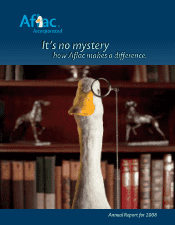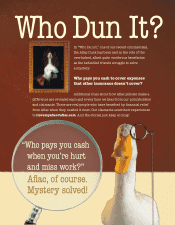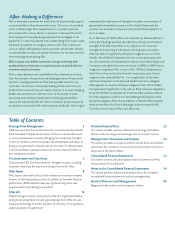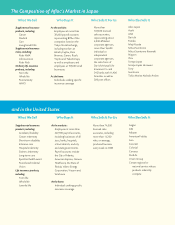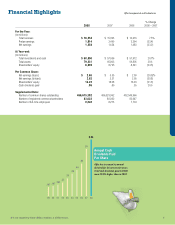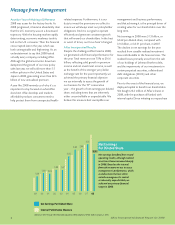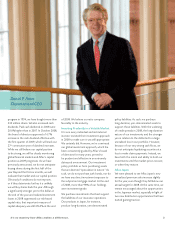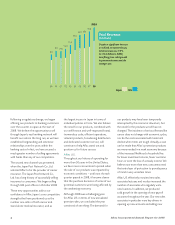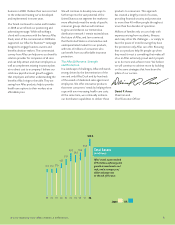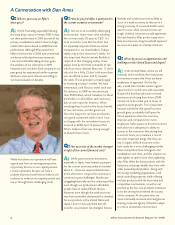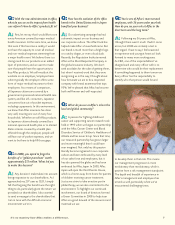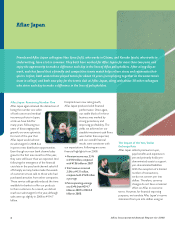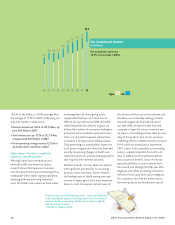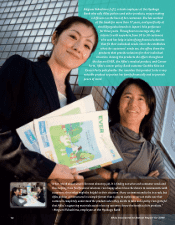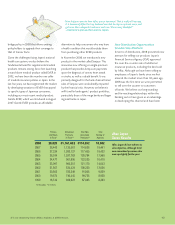Aflac 2008 Annual Report Download - page 7
Download and view the complete annual report
Please find page 7 of the 2008 Aflac annual report below. You can navigate through the pages in the report by either clicking on the pages listed below, or by using the keyword search tool below to find specific information within the annual report.
3
It’s no mystery how Aflac makes a difference.
program in 1994, we have bought more than
232 million shares. We also increased cash
dividends. Paid cash dividends in 2008 were
20.0% higher than in 2007. In October 2008,
the board of directors approved a 16.7%
increase in the cash dividend effective with
the first quarter of 2009, which will mark our
27th consecutive year of dividend increases.
While we still believe our capital position
to be strong, we will be closely monitoring
global financial markets and Aflac’s capital
position as 2009 progresses. As we have
previously announced, we do not anticipate
buying shares during the first half of the
year. Beyond the first six months, we will
evaluate that market and our capital position.
Obviously if conditions do not improve,
or if they deteriorate further, it is unlikely
we will buy shares back this year. Although
a significantly stronger yen to the dollar at
the end of the year and realized investment
losses in 2008 suppressed our risk-based
capital ratio, that important measure of
capital adequacy was still 476.5% at the end
of 2008. We believe our ratio compares
favorably to the industry.
Investing Prudently in a Volatile Market
I’m sure every individual and institutional
investor revisited their investment approach
in 2008 to make sure it was still appropriate.
We certainly did. However, we’re convinced
our global investment approach, which has
been consistently guided by Aflac’s board
of directors for many years, proved to
be prudent and effective in an extremely
distressed environment. Our investment
policy prohibits us from purchasing assets
that are deemed “speculative in nature.” As
such, we do not purchase junk bonds, nor do
we have any direct investment exposure to
the subprime mortgage market. At the end
of 2008, more than 98% of our holdings
were investment grade.
We purchase investments that best support
the liabilities of our insurance operations.
Our products in Japan, for instance,
produce long-duration, yen-denominated
policy liabilities. As such, we purchase
long-duration, yen-denominated assets to
support those liabilities. With the widening
of credit spreads in 2008, the long-duration
nature of our investments and the stronger
yen in relation to the dollar led to a large
unrealized loss in our portfolio. However,
because of our very strong cash flows, we
do not anticipate liquidating securities at a
loss to make claims payments. Instead, we
have both the intent and ability to hold our
investments until the market prices recover,
or when they mature.
Aflac Japan
We were pleased to see Aflac Japan’s new
annualized premium sales increase slightly
for the year, even though they fell below our
annual target for 2008. At the same time, we
remain encouraged about the opportunities
in the Japanese market, especially in light of
two new distribution opportunities that have
started gaining traction.
Daniel P. Amos
Chairman and CEO

